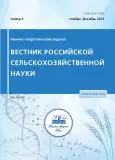Environmental problems of insecticides application in agriculture to combat blood-sucking dipterous insects
- Authors: Rotkin A.T1
-
Affiliations:
- The All-Russian Research Institute of Veterinary Entomology and Arachnology is a branch of the Federal State Budgetary Institution of Science of the Federal Research Center of the Tyumen Scientific Center of the Siberian Branch of the Russian Academy of Sciences
- Issue: No 6 (2023)
- Pages: 100-103
- Section: Articles
- URL: https://journals.rcsi.science/2500-2082/article/view/233595
- DOI: https://doi.org/10.31857/2500-2082/2023/6/100-103
- EDN: https://elibrary.ru/WQLSJM
- ID: 233595
Cite item
Full Text
Abstract
About the authors
A. T Rotkin
The All-Russian Research Institute of Veterinary Entomology and Arachnology is a branch of the Federal State Budgetary Institution of Science of the Federal Research Center of the Tyumen Scientific Center of the Siberian Branch of the Russian Academy of Sciences
Email: andreyrotkin2323@yandex.ru
References
- Анучина А.В. Токсическое действие пестицидов на организм человека и животных // Международный студенческий научный вестник. 2019. № 1. С. 1. EDN VVHVUE.
- Бойко Т.В., Герунова Л.К., Герунов В.И. и др. Токсикологическая характеристика неоникотиноидов // Вестник Омского государственного аграрного университета. 2015. № 4 (20). С. 49-54.
- Бурова О.А., Блохин А.А., Захарова О.И. и др. Векторы трансмиссивных вирусных болезней животных // Аграрная наука Евро-Северо-Востока. 2018. № 5 (66). С. 4-17.
- Гавричкин А.А., Хлызова Т.А., Федорова О.А, Сивкова Е.И. Защита сельскохозяйственных животных от кровососущих двукрылых насекомых в Тюменской области (обзор) // Таврический вестник аграрной науки. 2016. № 2(6). С. 36-47. EDN XIDEND.
- Герунов Т.В., Редькин Ю.В., Герунова Л.К. Иммунотоксичность пестицидов: роль в патологии животных и человека // Успехи современной биологии. 2011. Т. 131. № 5. С. 474-482.
- Давлианидзе Т.А., Еремина О.Ю. Санитарно-эпидемиологическое значение и резистентность к инсектицидам комнатных мух Musca domestica (Аналитический обзор литературы 2000-2021 гг.) // Вестник защиты растений. 2021. Т. 104. № 2. С. 72-86
- Крутько К.С., Кинарейкина А.Г., Серкова М.И. и др. Выявление в кровососущих двукрылых насекомых Тюменской области генетического материала возбудителей вирусных болезней животных // Российский паразитологический журнал. 2022;16(4):389-402.
- Курдиль Н.В., Иващенко О.В. Особенности острых отравлений в условиях города: карбаматы, пиретроиды, неоникотиноиды // Медицина неотложных состояний. 2015. № 4. С. 51-57.
- Лопатина Ю.В., Еремина О.Ю. Механизмы резистентности членистоногих к пестицидам: снижение проницаемости кутикулы и роль АВС-транспортеров // Медицинская паразитология и паразитарные болезни. 2018. № 4. С. 42-52.
- Медведев С.Г. Организация исследований насекомых комплекса гнуса (Diptera: Culicidae, Ceratopogonidae, Tabanidae) Ю.С. Балашовым // Паразитология. 2013. Т. 47. № 3. С. 245-260.
- Павлов С.Д., Федорова О.А., Сивкова Е.И. Защита сельскохозяйственных животных инсектицидной ловушкой для истребления слепней // Ветеринария и кормление. 2020. № 7. С. 49-52. doi: 10.30917/ATT-VK-1814-9588-2020-7-12. EDN QJATSR.
- Серкова М.И. Альтернативные методы борьбы с кровососущими комарами (DIPTERA:CULICIDAE) (Обзор) // Вестник КрасГАУ. 2021. №10 (175).
- Силиванова Е.А., Левченко М.А., Шумилова П.А, Плашкина В.А. Активность фосфатаз и ацетилхолинэстеразы у комнатной мухи Musca domestica L. на разных стадиях жизненного цикла // Евразиатский энтомологический журнал. 2020. Т. 19. № 3. С. 124-130.
- Соколянская М.П. Формирование резистентности к пиретроидам у личинок комнатной мухи Musca domestica // Агрохимия. 2014. № 3. С. 54-59.
- Eba K.D., Olkeba B.K. et al. Bio-Control of Anopheles Mosquito Larvae Using Invertebrate Predators to Support Human Health Programs in Ethiopia // International journal of environmental research and public health. 2021. Vol. 18. № 1810.
- Ehler L.E. Integrated pest management (IPM): definition, historical development and implementation, and the other IPM //Pest management science. 2006. Т. 62. №. 9. С. 787-789.
- Jacob S., Thomas A., Manju E. Bio control efficiency of Odonata nymphs on Aedes aegypti larvae // Journal of Environmental Science, Toxicology and Food Technology. 2017. Vol. 11. № 9. P. 1-4.
- Piechowicz B., Grodzicki P. Circadian and Seasonal Changes in Honeybee (Apis Mellifera) Worker Susceptibility to Pyrethroids // Polish Journal of Environmental Studies. 2016. Vol. 25. P. 1177-1185.
- Vreysen M.J.B. et al. Area-wide integrated pest management (AW-IPM): principles, practice and prospects //Area-wide control of insect pests: from research to field implementation. 2007. С. 3-33.
- Zhu F., Gujar H., Gordon J. et al. Bed bugs evolved unique adaptive strategy to resist pyrethroid insecticides. 2013. 3 (1): 1456.
Supplementary files










